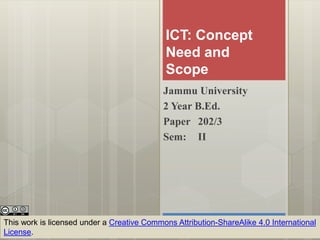
ICT concept need and scope
- 1. ICT: Concept Need and Scope Jammu University 2 Year B.Ed. Paper 202/3 Sem: II This work is licensed under a Creative Commons Attribution-ShareAlike 4.0 International License.
- 2. Information and communications technology (ICT) is often used as an extended synonym for information technology (IT) It is a more extensive term (i.e. more broad in scope) that stresses the role of unified communications and the integration of telecommunications (telephone lines and wireless signals), computers as well as necessary enterprise software, middleware, storage, and audio-visual systems, which enable users to access, store, transmit, and manipulate information.
- 3. The term ICT is also used to refer to the convergence of audio-visual and telephone networks with computer networks through a various linking systems. ICT covers any product that will store, retrieve, manipulate, transmit or receive information electronically in a digital form. Information and communication technology, or ICT, is defined as the combination of informatics technology with other, related technologies, specifically communication technology. ICT has no universal definition, since "the concepts, methods and applications involved in ICT are constantly evolving on an almost daily basis.”
- 4. Some underlying principles of ICT Technology does not exist in isolation ICT contributes at various points along a line of activity ICT is used in activities –the ICT use depends on the activities The key outputs of educational activities are context are knowledge, experience and products The output should be useful to the users (self and others)
- 5. ICT in Education the ever-growing computer-centric lifestyle, which includes the rapid influx of computers in the modern classroom. can contribute to- universal access to education, equity in education, the delivery of quality learning and teaching, teachers’ professional development and more efficient education management, governance and administration. Access, inclusion and quality are among the main challenges they can address. All governments aim to provide the most comprehensive education possible for their citizens within the constraints of available finance.
- 6. Scope of ICT Professional development for teachers Availability of resources ICT in schools Role of ICT in the class Expanding educational opportunities Increasing efficiency Enhancing quality of learning Enriching quality of teaching
- 7. Facilitating skill formation Establishing and sustaining lifelong learning Improving policy planning and management Advancing community linkages IT-Professional and Vocational Education in Information Technology Distance Learning Lifelong Learning Information Technology in Educational Management
- 8. enhance teaching helping the student learn that students can find information, they need proper instructions, they need scope for creativity, expectations of the teacher brings forth performance. Lively teaching learning process
- 9. Aspects of the educational use of ICT: supporting new pedagogical methods accessing remote resources enabling collaboration extending educational programs and developing skills for the workplace
- 10. Using ICT in Education ICT Education: most common understanding of the field of ICTs in education refers to the creation of human resource to meet the IT needs of the knowledge economy ICT in Education policy of a government describes the steps by which computers will be placed in schools, how teachers and students will be provided the basic computer programming skills to cater to the growing job market in computer based technologies.
- 11. ICT Supported Education: A large number of distance education universities and programmes use ICT to support the print content that they deliver to students. Include audio and video such as radio and television programmes, audio and video tapes delivered to students as part of a learning kit, and in more recent times, multimedia content such as lessons which are delivered off line, i.e. on CDs. This is also sometimes called multimedia education, where multiple media are used to support learning.
- 12. ICT Enabled Education: Any educational program that is purely delivered through ICTs, or with ICT delivered content as the primary backbone of the teaching-learning process, such as on line courses through the web, is ICT enabled education. This form of education requires ICT access and requires that the learner use ICTs as a primary or basic medium of instruction.
- 13. Strengths of ICTs Low per unit cost Distance and climate independent Can serve multiple teaching functions and diverse audiences High speed delivery, wide reach at low cost Uniform quality
- 14. Weaknesses of ICT: High infrastructure and start up costs Centralized uniform content: The larger the numbers, the lower the cost. (not taking into account individual differences) Are not ideally location and problem sensitive: Address problems in a general way, but cannot, without special effort, solve local and culturally sensitive problems. Problems of reach, access, remain: Not everyone has equal access; so not everyone benefits equally from the use of ICTs. Tend to create new class of knowledge rich/knowledge poor: Those who have access and knowledge through the media become richer and those who do not become poorer, widening the “knowledge or digital gap” between rich and poor.
- 15. Essentially delivery systems: A medium is different from the content; and often we forget that we can deliver any content, because ICTs are essentially meant only to deliver content, not to change attitudes or bring about behaviour change. ™ Hard to assess impact: Learning from ICT delivered content is difficult to assess since such learning is of a multidimensional and long term kind, rather than from immediate learning assessment as in a classroom test. Reorientation and retraining Attitudinal change to understanding of teaching and learning
